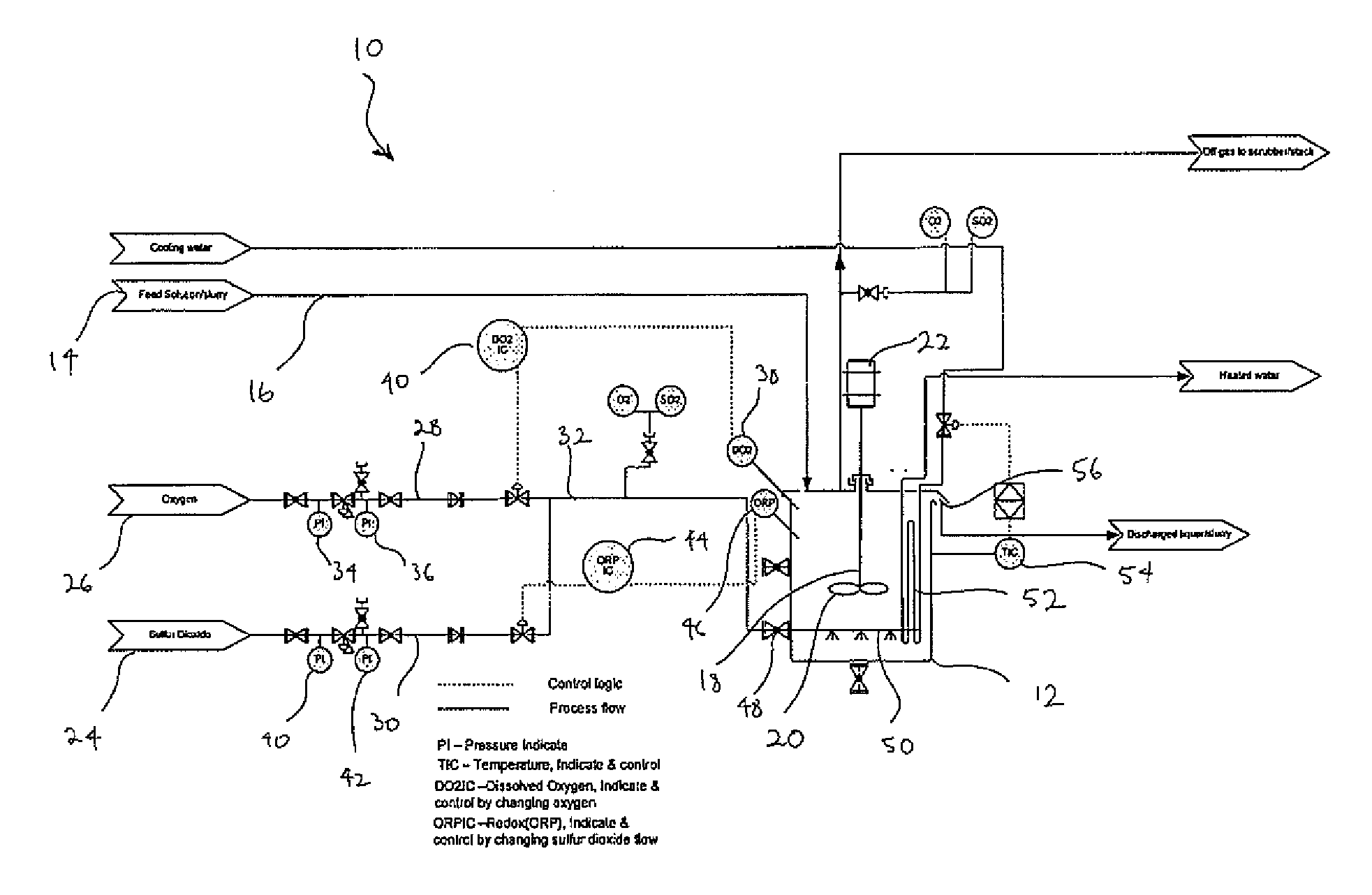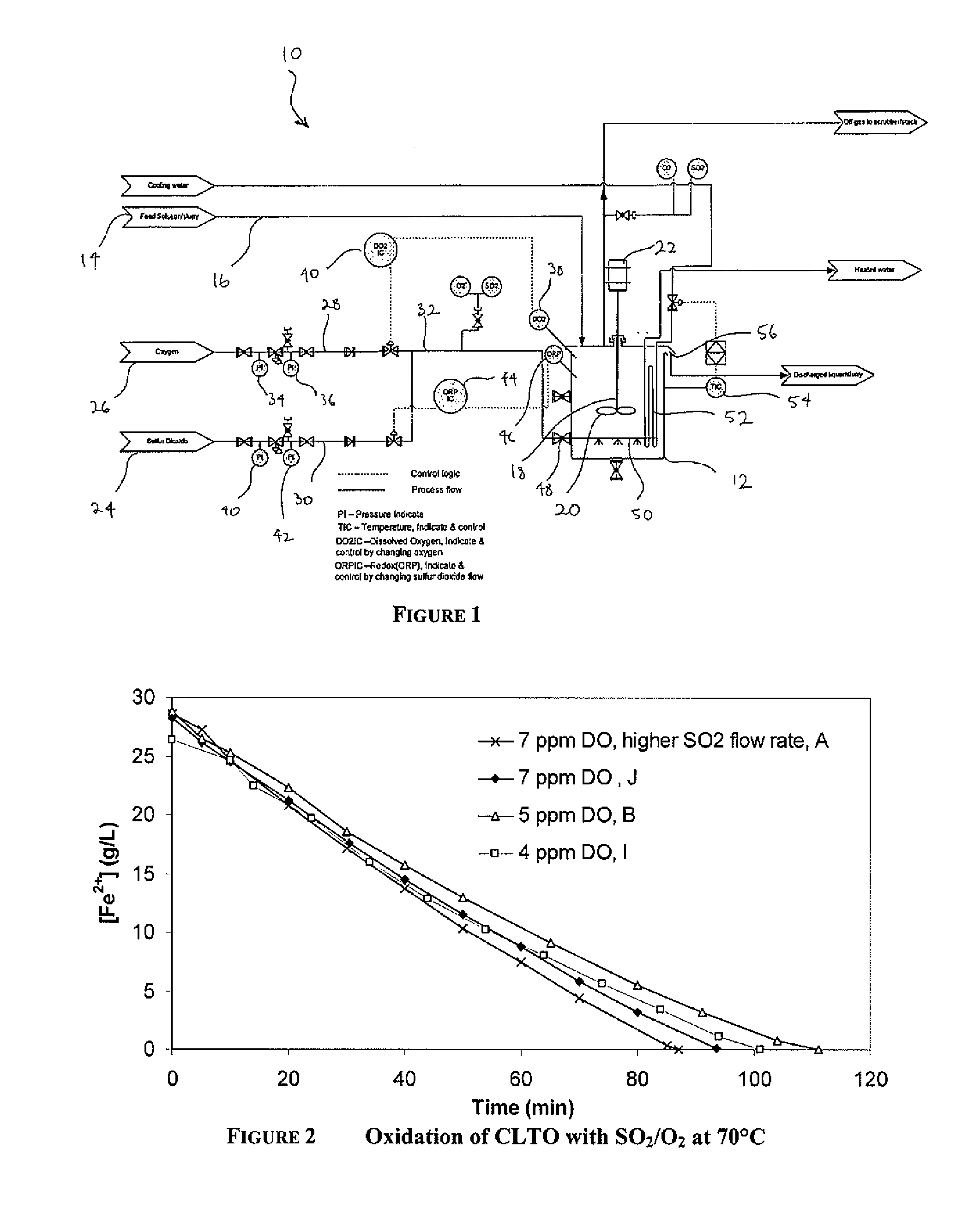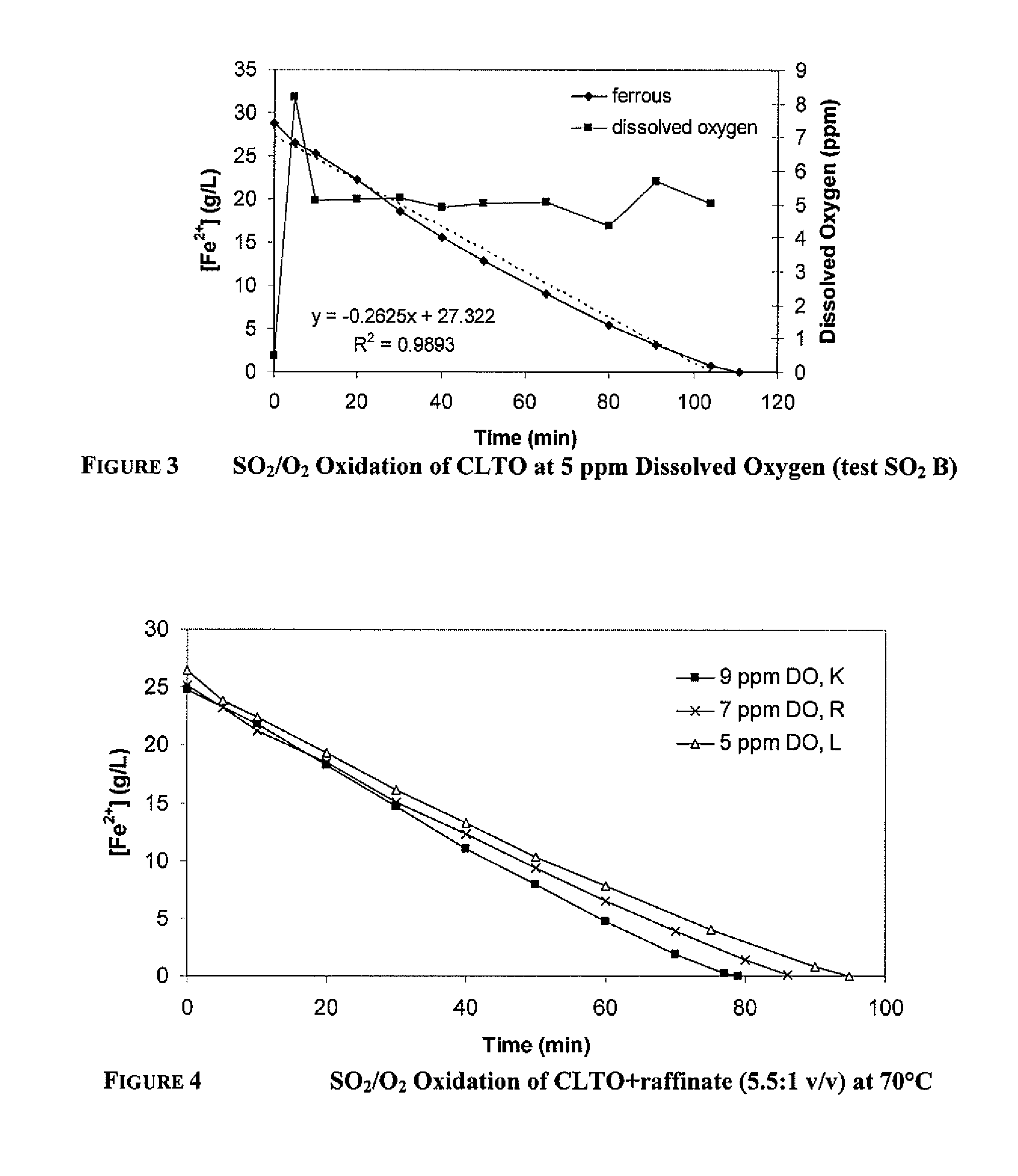Process for Controlled Oxidation of a Ferrous Solution
a technology of ferrous ions and oxidation processes, which is applied in the direction of halogen oxides/oxyacids, organic/inorganic per-compound compounding agents, manufacturing converters, etc., can solve the problem of undesirable reversed reaction of ferrous oxidation
- Summary
- Abstract
- Description
- Claims
- Application Information
AI Technical Summary
Benefits of technology
Problems solved by technology
Method used
Image
Examples
examples 1 to 4
[0078]FIG. 1 is a schematic diagram of a plant 10 for use with the process of the present invention as exemplified in Examples 1 to 4. The plant 10 includes a reactor 12 into which a ferrous containing feed solution or slurry 14 is fed via a conduit 16. The reactor 12 includes a dissolved oxygen sensor 38, a redox sensor 46 and an agitator 18 comprising an impeller 20 driven by a motor 22. Sources of sulfur dioxide 24 and oxygen gas 26, respectively, are in fluid communication with the reactor 12 via gas inlet conduit 32. An oxygen conduit 28 extends from the oxygen source and a sulfur dioxide conduit 24 extends from the sulfur dioxide source. The two conduits are connected to inlet conduit 32. The oxygen conduit 28 includes oxygen pressure gauges 34 and 36 and means 40 for regulating the flow of oxygen through conduit 28 in response to readings from the DO sensor 38. The sulfur dioxide conduit 30 includes sulfur dioxide pressure gauges 40 and 42 and a means 44 for regulating the fl...
example 1
Solution 1: CLTO
[0095]Table 3 sets out the conditions of each oxidation test.
TABLE 3SO2 / O2 Oxidation of CLTO at 70° C.CalculatedFe2+Max. Fe2+oxidationIncreaseDissolvedoxidation rateAverage Fe2+Fe2+ oxidationrate belowinTestOxygenbased on SO2oxidation raterate to 4-6 g / L4-6 g / L Fe2+[H2SO4]ID(ppm)(g / L / h)(g / L / h)Fe2+ (g / L / h)(g / L / h)(g / L)SO2 A7~2720201611SO2 J7~2218191412SO2 B5~2216171215SO2 C5~171212na8SO2 I4.5~2416171317
[0096]The decrease in ferrous concentration from SO2 / O2 oxidation of CLTO at 70° C. and dissolved oxygen from 4-7 ppm is shown in FIG. 2.
[0097]The SO2 flowrate was equivalent to a maximum Fe2+ oxidation rate of 22-24 g / L / h, except for test SO2 A, where the SO2 flow rate was equivalent to a maximum Fe2+ oxidation rate of 27 g / L / h. The test at 4.5 ppm dissolved oxygen (DO) had a slightly lower initial ferrous concentration because oxygen was sparged through the liquor for five minutes before SO2 was added. It can be seen that maintaining an optimum value of dissolved oxyge...
example 2
Solution 2: CLTO+Raffinate
[0103]The decrease in ferrous concentration from SO2 / O2 oxidation of CLTO+raffinate (166 mL:30 mL or 5.5:1 / vv) at 70° C. is shown in FIG. 4. The SO2 feed rate was equivalent to a maximum Fe2+ oxidation rate of 22-23 g / L / h. The selectivity of ferrous oxidation reaction (1) over the acid generation reaction (3) decreased as the dissolved oxygen concentration decreased from 9 ppm to 5 ppm. Similarly to oxidation of CLTO, the ferrous oxidation rate decreased once the ferrous became depleted.
[0104]One test was run on CLTO:raffinate=1:1 (v / v) and the results are shown in FIG. 5. The SO2 feed rate was equivalent to a maximum Fe2+ oxidation rate of 17-24 g / L / h.
[0105]The ferrous oxidation rates are shown in Table 5.
TABLE 4CalculatedFe2+Fe2+Max. Fe2+AverageoxidationoxidationoxidationFe2+rate torateIncreaseRatioDissolvedrate basedoxidation4-6 g / LbelowinCLTO:raffinateOxygenon SO2rateFe2+3-5 g / L[H2SO4](v / v)Test ID(ppm)(g / L / h)(g / L / h)(g / L / h)(g / L / h)(g / L)5.5:1SO2 K 9221920....
PUM
| Property | Measurement | Unit |
|---|---|---|
| concentration | aaaaa | aaaaa |
| flow rate | aaaaa | aaaaa |
| partial pressure | aaaaa | aaaaa |
Abstract
Description
Claims
Application Information
 Login to View More
Login to View More - R&D
- Intellectual Property
- Life Sciences
- Materials
- Tech Scout
- Unparalleled Data Quality
- Higher Quality Content
- 60% Fewer Hallucinations
Browse by: Latest US Patents, China's latest patents, Technical Efficacy Thesaurus, Application Domain, Technology Topic, Popular Technical Reports.
© 2025 PatSnap. All rights reserved.Legal|Privacy policy|Modern Slavery Act Transparency Statement|Sitemap|About US| Contact US: help@patsnap.com



